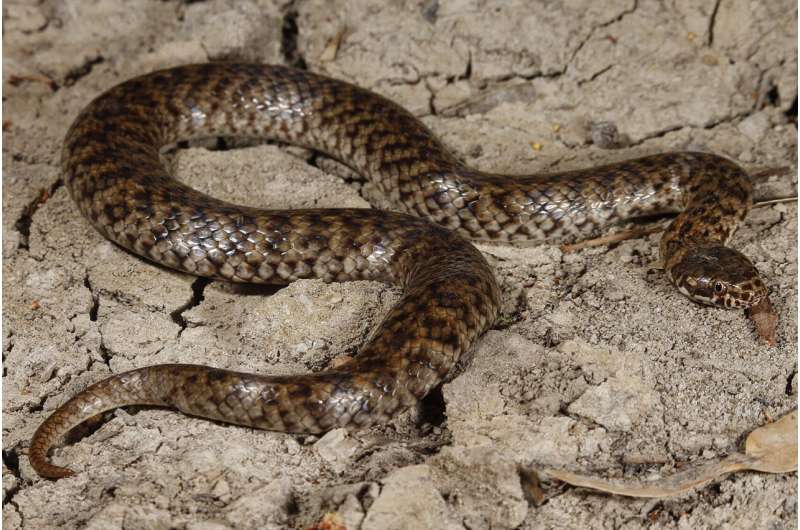First sighting of venomous mud adder in South Australia

A venomous snake normally found only in the eastern states has been detected in South Australia for the first time, near the border with NSW and Victoria.
The De Vis' banded snake, also known as the mud adder (Denisonia devisi), is critically endangered in Victoria, but a University of South Australia (UniSA) Ph.D. student and local herpetologists recently recorded several nocturnal sightings in the Chowilla Game Reserve near Renmark.
The discovery is published in the latest issue of Herpetological Conservation and Biology.
UniSA Ph.D. student Shawn Scott says the detection of four adult mud adders near an isolated pool brings South Australia's total number of venomous snake species to 37.
"We found one De Vis' banded snake with its head exposed and its body and tail concealed in a soil crack while biting onto the left hind limb and thigh of a large adult Southern Bell frog," Scott says.
The three other snakes were all found in the same vicinity, one at the base of a large River Red Gum and the others in soil cracks.
The discovery underlines the need for greater conservation efforts in Australia's river systems, particularly for reptiles, as many snake species are small and live in isolated or specialized ecosystems, the authors say.
De Vis' banded snake is widespread through central and southern Queensland and northern NSW but is critically endangered in Victoria, hence the significance of the finding.
It is a front-fanged medium-sized snake, up to 60 centimeters in length, yellow-to-orange-brown, or olive basal in color, and often confused with a death adder.
The snake's scientific and common names refer to Charles Walter de Vis (1829–1915), first director of the Queensland Museum and renowned herpetologist.
Frogs are their main diet, as recorded by Scott and his team, with the predator-prey sighting believed to be the first visual record of Denisonia devisi consuming a Southern Bell frog, which is also threatened.
"We also observed the De Vis' banded snake repeatedly strengthening its bite on the frog's thigh, likely to stop it escaping and then injecting its venom. Because these snakes are ambush predators, we think it may have been foraging near the surface and through chemoreception (using its tongue to detect scent particles), located and struck the frog."
The Elapid family (front-fanged venomous snakes) comprises 109 Australian species, as well as Cobras found overseas. There are also many small species with weak venoms, which are not considered to be dangerous to humans.
"If we are to mitigate biodiversity loss among our reptiles, we need to monitor not only remote or poorly understood ecosystems, but also areas that have extensive survey histories, which could result in the discovery of species that may have been undetected in the past," Scott says.
More information: Shawn Scott et al, De Vis' Banded Snake, Denisonia devisi (Squamata: Elapidae): an Addition to the Elapid Fauna of South Australia with Notes on Its Ecology and Conservation, Herpetological Conservation and Biology (2022). www.herpconbio.org/Volume_17/I … /Scott_etal_2022.pdf
Provided by University of South Australia




















